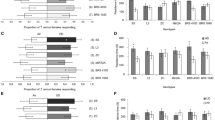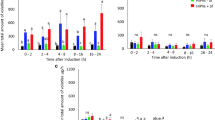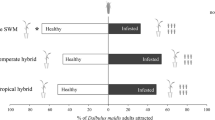Abstract
Plants have evolved intricate defence strategies against herbivore attack which can include activation of defence in response to stress-related volatile organic compounds (VOCs) emitted by neighbouring plants. VOCs released by intact molasses grass (Melinis minutiflora), have been shown to repel stemborer, Chilo partellus (Swinhoe), from maize and enhance parasitism by Cotesia sesamiae (Cameron). In this study, we tested whether the molasses grass VOCs have a role in plant-plant communication by exposing different maize cultivars to molasses grass for a 3-week induction period and then observing insect responses to the exposed plants. In bioassays, C. partellus preferred non-exposed maize landrace plants for egg deposition to those exposed to molasses grass. Conversely, C. sesamiae parasitoid wasps preferred volatiles from molasses grass exposed maize landraces compared to volatiles from unexposed control plants. Interestingly, the molasses grass induced defence responses were not observed on hybrid maize varieties tested, suggesting that the effect was not simply due to absorption and re-emission of VOCs. Chemical and electrophysiological analyses revealed strong induction of bioactive compounds such as (R)-linalool, (E)-4,8-dimethyl-1,3,7-nonatriene and (E,E)-4,8,12-trimethyl-1,3,7,11-tridecatetraene from maize landraces exposed to molasses grass volatiles. Our results suggest that constitutively emitted molasses grass VOCs can induce direct and indirect defence responses in neighbouring maize landraces. Plants activating defences by VOC exposure alone could realize enhanced levels of resistance and fitness compared to those that launch defence responses upon herbivore attack. Opportunities for exploiting plant-plant signalling to develop ecologically sustainable crop protection strategies against devastating insect pests such as stemborer C. partellus are discussed.








Similar content being viewed by others
References
Aitchison J (1986) The statistical analysis of compositional data. Chapman and Hall, London XII 416pp
Baldwin IT, Halitschke R, Paschold A, Von Dahl CC, Preston CA (2006) Volatile signaling in plant-plant interactions: “talking trees” in the genomics era. Science 311:812–815
Bruce TJA, Wadhams LJ, Woodcock CM (2005) Insect host location: a volatile situation. Trends Plant Sci 10(6):269–274
Bruce TJA, Midega CAO, Birkett MA, Pickett JA, Khan ZR (2010) Is quality more important than quantity? Insect behavioural responses to changes in a volatile blend after stemborer oviposition on an African grass. Biol Lett 6:314–317
Bruce TJA, Pickett JA (2011) Perception of plant volatile blends by herbivorous insects finding the right mix. Phytochem 72:1605–1611
Cheruiyot D, Midega CAO, Bruce TJA, Van den Berg J, Pickett JA, Khan ZR (2018) Suitability of Brachiaria grass as a trap crop for management of Chilo partellus. Entomol Exp Appl 166:139–149
Dahlin I, Vucetic A, Ninkovic V (2015) Changed host plant volatile emissions induced by chemical interaction between unattacked plants reduce aphid plant acceptance with intermorph variation. J Pest Sci 88:249–257
De Moraes CM, Mescher MC, Tumlinson JH (2001) Caterpillar-induced nocturnal plant volatiles repel conspecific females. Nature 410:577–580
Dicke M, van Loon JJA (2000) Multitrophic effects of herbivore induced plant volatiles in an evolutionary context. Entomol Exp Appl 97:237–249
Glinwood R, Ahmed E, Qvarfordt E, Ninkovic V, Pettersson J (2009) Airborne interactions between undamaged plants of different cultivars affect insect herbivores and natural enemies. Arthropod-Plant Interact 3:215–224
Glinwood R, Ninkovic V, Pettersson J (2011) Chemical interaction between undamaged plants-effects on herbivores and natural enemies. Phytochemistry 72(13):1683–1689
Hassanali A, Herren H, Khan ZR, Pickett JA, Woodcock CM (2008) Integrated pest management: the push-pull approach for controlling insect pests and weeds of cereals, and its potential for other agricultural systems including animal husbandry. Philos Trans Royal Soc B 363:611–621
Heil M, Silva Bueno JC (2007) Within-plant signaling by volatiles leads to induction and priming of an indirect plant defense in nature. Proc Natl Acad Sci U S A 104:5467–5472
Heil M (2008) Indirect defence via tritrophic interactions. New Phytol 178:41–61
Heil M, Karban R (2010) Explaining evolution of plant communication by airborne signals. Trends Ecol Evol 25:137–144
Himanen SJ, Blande JD, Klemola T, Pulkkinen J, Heijari J, Holopainen JK (2010) Birch (Betula spp.) leaves adsorb and re-release volatiles specific to neighbouring plants - A mechanism for associational herbivore resistance? New Phytologist 186(3):722–732
Karban R, Yang LH, Edwards KF (2014) Volatile communication between plants that affects herbivory: a meta-analysis. Ecol Lett 17:44–52
Kessler A, Baldwin IT (2001) Defensive function of herbivore-induced plant volatile emissions in nature. Sci 291:2141–2144
Kfir R, Overholt WA, Khan ZR, Polaszek A (2002) Biology and management of economically important lepidopteran cereal stem borers in Africa. Annu Rev Entomol 47:701–731
Khan ZR, Ampong-Nyarko K, Chiliswa P, Hassanali A, Kimani S, Lwande W, Overholt WA (1997) Intercrop** increases parasitism of pests. Nature 388:631–632
Khan ZR, Pickett JA, Van den Berg J, Wadhams LJ, Woodcock CM (2000) Exploiting chemical ecology and species diversity. Stemborer and Striga control for maize and sorghum in Africa. Pest Manag Sci 56:957–962
Khan ZR, Midega CAO, Hutter NJ, Wilkins RM, Wadhams LJ (2006) Assessment of the potential of Napier grass (Pennisetum purpureum) varieties as trap plants for management of Chilo partellus. Entomol Exp Appl 119:15–22
Khan ZR, Midega CAO, Wadhams LJ, Pickett JA, Mumuni A (2007) Evaluation of Napier grass (Pennisetum purpureum) varieties for use as trap plants for the management of African stemborer (Busseola fusca) in a push-pull strategy. Entomol Exp Appl 124:201–211
Khan ZR, Midega CAO, Bruce TJA, Hooper AM, Pickett JA (2010) Exploiting phytochemicals for develo** the push-pull crop protection strategy for cereal farmers in Africa. J Exp Bot 61:4185–4196
Konstantopoulou MA, Krokos FD, Mazomenos BE (2002) Chemical stimuli from corn plants affect host selection and oviposition behaviour of Sesamia nonagrioides (Lepidoptera: Noctuidae). J Econ Entomol 95:1289–1293
Maddrell SHP (1969) Secretion by the Malphigian tubules of Rhodnius. The movement of ions and water. J Exp Biol 51:71–97
Mutyambai DM, Bruce TJA, van den Berg J, Midega CAO, Pickett JA, Khan ZR (2016) An indirect defence trait mediated through egg-induced maize volatiles from neighbouring plants. PLoS One 11(7):e0158744. https://doi.org/10.1371/journal.pone.0158744
Ninkovic V, Dahlin I, Vucetic A, Petrovic-Obradovic O, Glinwood R, Webster B (2013) Volatile exchange between undamaged plants - a new mechanism affecting insect orientation in intercrop**. PLoS One 8:e69431. https://doi.org/10.1371/journal.pone.0069431
Ninkovic V, Glinwood R, Dahlin I (2009) Weed-barley interactions affect plant acceptance by aphids in laboratory and field experiments. Entomol Exp Appl 133:38–45
Ninkovic V, Rensing M, Dahlin I, Markovic D (2019) Who is my neighbor? Volatile cues in plant interactions. Plant Signal Behav 3:1–6. https://doi.org/10.1080/15592324.2019.1634993
NIST (2005) NIST mass spectral search for the NIST/EPA/NIH mass spectral library version 2.0. Office of the standard reference data base. National Institute of Standards and Technology, Gaithersburg, Maryland
Ntiri ES, Calatayud PA, Van den Berg J, Schulthess F, Le Ru B (2016) Influence of temperature on intra- and interspecific resource utilisation within a community of lepidopteran maize stemborers. PLOS ONE 11(2):e0148735. https://doi.org/10.1371/journal.pone.0148735
Ntiri ES, Calatayud PA, Musyoka B, Van den Berg J, Le Ru BP (2019) Spatio-temporal interactions between maize lepidopteran stemborer communities and possible implications from the recent invasion of Spodoptera frugiperda (Lepidoptera: Noctuidae) in sub-Saharan Africa. Env Entomol 48:573–582
Nylin S, Janz N (1996) Host plant preference in the comma butterfly (Polygonia c-album): do parents and offspring agree? Ecoscience 3:285–289
Ochieng RS, Onyango FO, Bungu MDO (1985) Improvement of techniques for mass-culture of Chilo partellus (Swinhoe). Insect Sci Appl 6:425–428
Pickett JA, Khan ZR (2016) Plant volatile-mediated signalling and its application in agriculture: successes and challenges. New Phytol 212(4):856–870
Pickett JA, Bruce TJA, Chamberlain K, Hassanali A, Khan ZR, Matthes MC, Napier JA, Smart LE, Wadhams LJ, Woodcock CM (2006) Plant volatiles yielding new ways to exploit plant defence. In: Dicke M, Takken W (eds) Chemical ecology from gene to ecosystem. Springer, The Netherlands, pp 161–173
Renwick JAA, Chew FS (1994) Oviposition behaviour in lepidoptera. Annu Rev Entomol 39:377–400
R Core Team (2015) R: a language and environment for statistical computing. R Foundation for Statistical Computing, Vienna
Tamiru A, Getu E, Jembere B (2007) Role of some ecological factors for an altitudinal expansion of Chilo partellus (Sinhoe) (Lepidoptera: Crambidae). SINET: Ethiop J Sci 30:71–76
Tamiru A, Bruce TJA, Woodcock CM, Caulfield JC, Midega CAO, Ogol CKPO, Mayon P, Birkett MA, Pickett JA, Khan ZR (2011) Maize landraces recruit egg and larval parasitoids in response to egg deposition by a herbivore. Ecol Lett 14:1075–1083
Tamiru A, Bruce TJA, Midega CAO, Woodcock CM, Birkett MA, Pickett JA, Khan ZR (2012) Oviposition induced volatile emissions from African smallholder farmers’ maize varieties. J Chem Ecol 38:231–234
Tamiru A, Bruce TJA, Woodcock CM, Birkett MA, Midega CAO, Pickett JA, Khan ZR (2015) Chemical cues modulating electrophysiological and behavioural responses in the parasiticwasp. Cotesia sesamiae. Can J Zool 93:281–287
Ton J, D’Alessandro M, Jourdie V, Jakab G, Karlen D, Held M, Mauch-Mani B, Turlings TCJ (2006) Priming by airborne signals boosts direct and indirect resistance in maize. Plant J 49:16–26
Vucetic A, Dahlin I, Petrovic-Obradovic O, Glinwood R, Webster B, Ninkovic V (2014) Volatile interaction between undamaged plants affects tritrophic interactions through changed plant volatile emission. Plant Signal Behav 9(8):e29517. https://doi.org/10.4161/psb.29517
Acknowledgements
We are grateful to western Kenya farmers who provided the local maize cultivars. We thank Amos Gadi, Isaac Odera, Silas Ouko, and Daniel Simiyu for insect rearing, technical assistance and screen house operations and Daisy Salifu for statistical advice. T.A.T. was supported by a German Academic Exchange Service (DAAD) In-Region Postgraduate Scholarship. icipe gratefully acknowledge the financial support by European Union, UK’s Department for International Development (DFID), Swedish International Development Cooperation Agency (Sida), the Swiss Agency for Development and Cooperation (SDC), Federal Democratic Republic of Ethiopia and the Kenyan Government. The views expressed herein do not necessarily reflect those of these donors.
Author information
Authors and Affiliations
Corresponding author
Rights and permissions
About this article
Cite this article
Tolosa, T.A., Tamiru, A., Midega, C.A.O. et al. Molasses Grass Induces Direct and Indirect Defense Responses in Neighbouring Maize Plants. J Chem Ecol 45, 982–992 (2019). https://doi.org/10.1007/s10886-019-01122-z
Received:
Revised:
Accepted:
Published:
Issue Date:
DOI: https://doi.org/10.1007/s10886-019-01122-z




